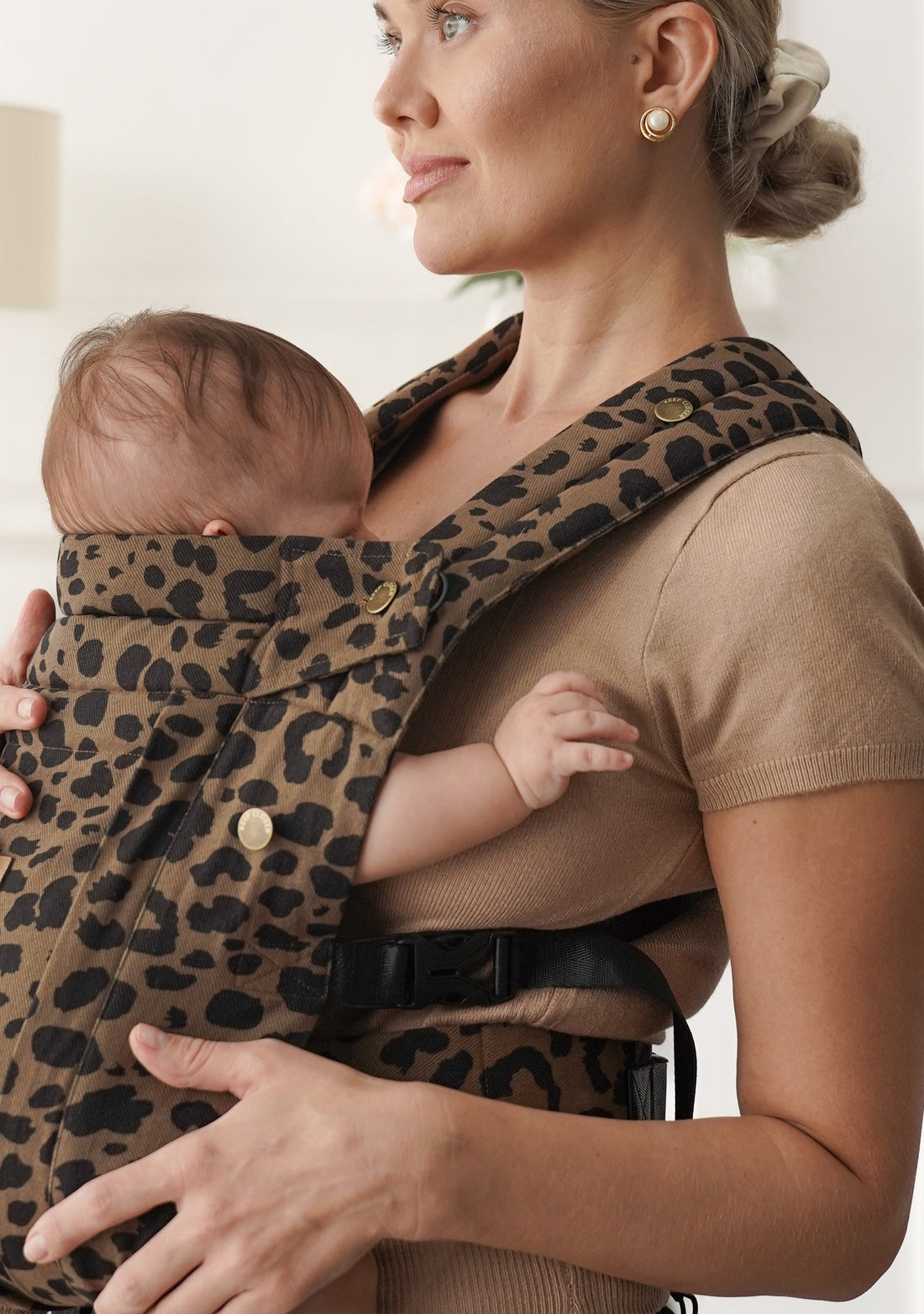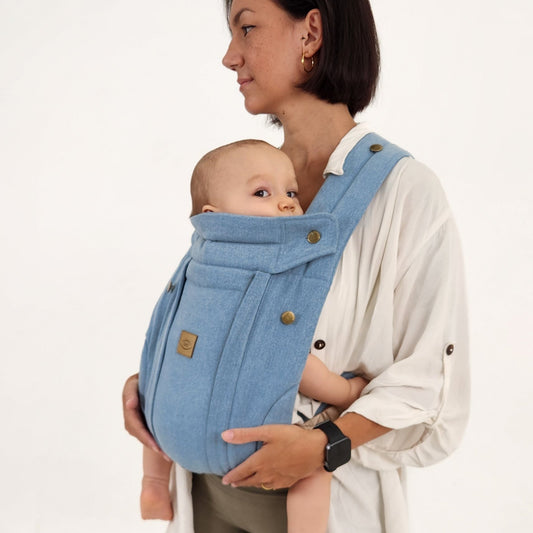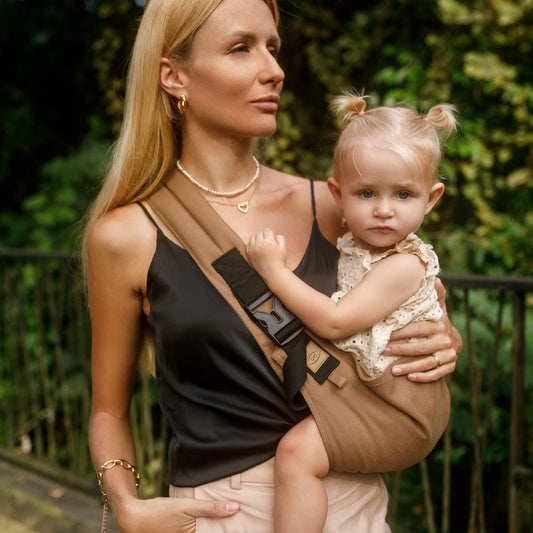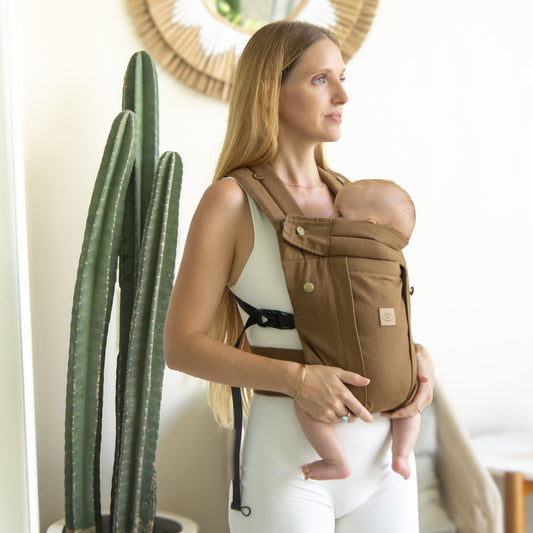
Newborn Babywearing: Parents Safety Guide & Tips | Keep Closer
Share
Thinking About Babywearing Your Newborn? Here’s What to Know First
Welcoming a newborn baby into your world is an incredible, beautiful moment. But let's be honest, it's also a huge change for everyone, your baby included! For nine months, your little one was curled up safely, warm and comfy. Now, the world outside is big, bright, and noisy. It naturally takes them time to adjust.
At the same time, as a new parent (especially if it's your first time!), handling such a tiny baby can feel a bit overwhelming. It's totally normal to look for ways to keep your baby close, give them comfort, and help that amazing bonding process along. That's where newborn babywearing often comes in. While using a baby carrier for your newborn can be wonderful for both of you, there are some really important things to understand before you dive in, especially when they're so little.
At Keep Closer, we believe that knowing how to do things safely is key. This guide is here to walk you through the must knows for safe newborn carrying, so you can feel confident and keep your baby secure.
Why Carrying Your Newborn Needs That Extra Bit of Care
Newborn babies are amazing, but they're also delicate and still developing. Their spine, hips, and neck muscles just aren't ready for all types of movement or positions yet. That's why safe babywearing practices for infants are so crucial.
It's also good to know that while many brands say their carriers are "newborn-friendly," there isn't a strict, universal rule or test that guarantees every carrier labeled this way is truly the best or safest for every newborn. Even a carrier that's "certified" might not be the perfect fit for your tiny baby or feel right on your body. This is exactly why taking a little time to learn, and maybe even chat with an expert on how to choose a baby carrier for a newborn, can make such a difference.
There's a lot of info out there, and it can feel like a lot to take in! So, in this post, we want to share some simple, clear tips and things to be aware of before you start using a newborn infant carrier.
Getting Started: A Few Things to Check Off Your List
Before you even think about putting your baby in a carrier, a little prep can go a long way for safety and peace of mind.
1. Educate Yourself.
Before you buy a baby carrier or start using one with your newborn, we highly recommend taking a little time to educate yourself about safe babywearing.
You can start by:
- Reading trusted articles about newborn babywearing
- Watching educational YouTube videos made by qualified babywearing specialists
- Purchasing a babywearing guide or a book about safe babywearing techniques
- If you prefer hands-on guidance, booking a personal session with a babywearing consultant can be a great investment too.
Even spending an hour learning the basics can make a huge difference in your confidence and understanding.
And of course, always check with your pediatrician before using any carrier, especially if:
- Your baby was born prematurely
- Your baby had low birth weight
- There are any diagnosed or suspected medical concerns (such as hip dysplasia, reflux, breathing issues, spine or neck concerns)
- You have any doubts about whether your baby is ready for babywearing
The more you learn in advance, the better equipped you will be to choose the right carrier for your newborn and to use it safely and comfortably from the start.
2. Is Your Baby Ready? Thinking About Weight and Development
Most healthy newborns weigh around 3.2 to 3.4 kg (that's about 7 to 7.5 lbs) or a bit more. If your baby is on the smaller side, sometimes a soft stretchy baby wrap for newborns is a better starting point than a more structured carrier. Wraps can often give that really close, snug feeling that tiny babies love in the very early weeks.
Generally, just be patient. If your baby is still getting used to life on the outside, sometimes waiting a couple of weeks and just focusing on lots of skin-to-skin cuddles at home is a lovely, gentle way to start your bonding journey before introducing a newborn carrier.
The Golden Rules: Keeping Your Newborn Safe in a Carrier
Okay, so you're feeling ready. Whenever you carry your baby, especially a newborn, these safety points are non-negotiable.
Know Your T.I.C.K.S. for Safe Babywearing
T.I.C.K.S. is an easy way to remember the basics for every single carry:
- T – Tight: The carrier needs to be snug enough to hold your baby close to your body. If it's too loose, they can slump, which isn't good for their breathing.
- I – In View at All Times: You should always be able to see your baby’s face just by looking down. No fabric should be covering their face.
- C – Close Enough to Kiss: Your baby’s head should be close enough to your chin that you can easily lean down and kiss the top of their head.
- K – Keep Chin Off Chest: This is a big one. If your baby’s chin is pushed onto their chest, it can make it hard for them to breathe. Make sure there’s always a little space (about a finger-width) under their chin.
- S – Supported Back: Baby’s back should be supported in its natural gentle curve, with their tummy and chest resting snugly against you in an upright carrier.
Instructions -> Your dedicated safety/instructions page.
Breathing Easy: Protecting Airways and Supporting That Little Head
A newborn’s breathing passages are tiny. Besides keeping their chin off their chest, make sure their face isn’t squished against you or the carrier. Their head and neck need full support since they can't hold their head up well yet. The carrier should gently support their head so it rests naturally, not flopping or pushed into an odd angle.
Healthy Hips from Day One: The M-Position and Hip Dysplasia
You might hear about newborn hip dysplasia – it's where the hip joint doesn't quite develop right. While some babies have a higher chance of this, all newborns have soft, developing hips. Those first 6 months are super important for healthy hip growth.
That's why getting the "M-position" right in a baby carrier is so important. It means your baby's bottom is a bit lower than their knees, and their thighs are supported from one knee to the other, making an 'M' shape. A carrier that isn't designed well or doesn't fit right, letting a newborn's legs dangle straight down or spreading them too wide, can stress their little hip joints. This is a key thing when looking for the best newborn carrier for hip support.
If hip dysplasia is a concern for your baby, always talk to your doctor and a babywearing specialist who knows about it before using any carrier. They can give you the best advice.
"Newborn-Friendly" Claims: Choosing a Carrier That’s *Actually* Safe
Lots of brands say their carriers are "newborn-friendly." As a parent, it's smart to look past the marketing and know what really makes a carrier safe and supportive for a brand new baby.
Watch Out For These Common Issues in "Newborn" Carriers:
- The body panel is too tall: Baby's face might get covered, or pressed into the fabric, making breathing unsafe. This is a major newborn baby carrier safety worry.
- The body panel is too wide: This can overstretch a newborn's little legs or squish their hips too much.
- Too much loose fabric or not enough support: Baby's back and neck aren't held firmly, and they can slump.
- Can't get it small enough: If you can't adjust the carrier for a really snug fit on a small newborn, they can slump inside, risking their airway (chin falling to chest).
Parent Tip: Do your own digging. Pretty pictures on social media don't always show the safest or best ways to position a newborn. Trust info from trained babywearing educators and your health pros more than just marketing shots.
What to *Really* Look For in a Newborn-Ready Carrier:
- Soft, Breathable Fabrics: Think gentle materials like quality cotton. This is especially true if you're in a warm place like Bali! A lightweight baby carrier for newborns made from breathable fabric helps stop them from overheating.
- Good Adjustability: The carrier needs to adjust well to get a snug, secure fit for your newborn's size *and* for your body. Being able to tweak the panel height and width is a plus.
- Built-in Head and Neck Support: It should have a smart way to gently hold and support your newborn's head and neck.
- Clear Instructions: Good brands give you detailed, easy-to-understand instructions on how to use their carrier safely with a newborn, including weight minimums. Video guides are super helpful too.
- Designed for Little Bodies: It should help get that M-position for hips and support the natural C-curve of a newborn's spine.
See Our Comfort Fit Collection
You've Got This! Tips for New Parents Starting with a Carrier
Using a carrier for the first time can feel a little fiddly. Totally normal! You're learning something new.
Getting Comfy and Confident:
- Read the Manual: Seriously, it’s your best friend for figuring out your specific carrier.
- Ask for Help if it's Offered: If your carrier brand gives free consultations (like Keep Closer does for our customers with the Comfort Fit carrier!), take them up on it.
- Phone a Friend (or Partner!): Have someone help you the first few times you try it on. Best to do this over a soft spot, like your bed.
- Practice Makes Progress: Try it with a teddy bear or doll first. Then, try with your baby at home when things are calm, just for short bits, before you head out on a big adventure.
Final Thoughts
Babywearing can be one of the most beautiful and beneficial things you do for your newborn and for yourself as a parent. It promotes closeness, bonding, emotional security, and even healthy physical development.
But the wrong carrier, or an incorrect fit, can sadly cause harm that may not show immediately but can affect your child’s long-term health. This is why we believe babywearing is more serious than many parents realize, and that taking the time to learn is one of the best gifts you can give your little one.
At Keep Closer, we prioritize safety and comfort above all. We encourage all parents to consult with babywearing experts, listen to their own intuition, and always put their baby’s well-being first.
If you would like help learning how to fit our Comfort Fit carrier for newborn use, we offer free online consultations. Simply contact us and we will be happy to support you.




